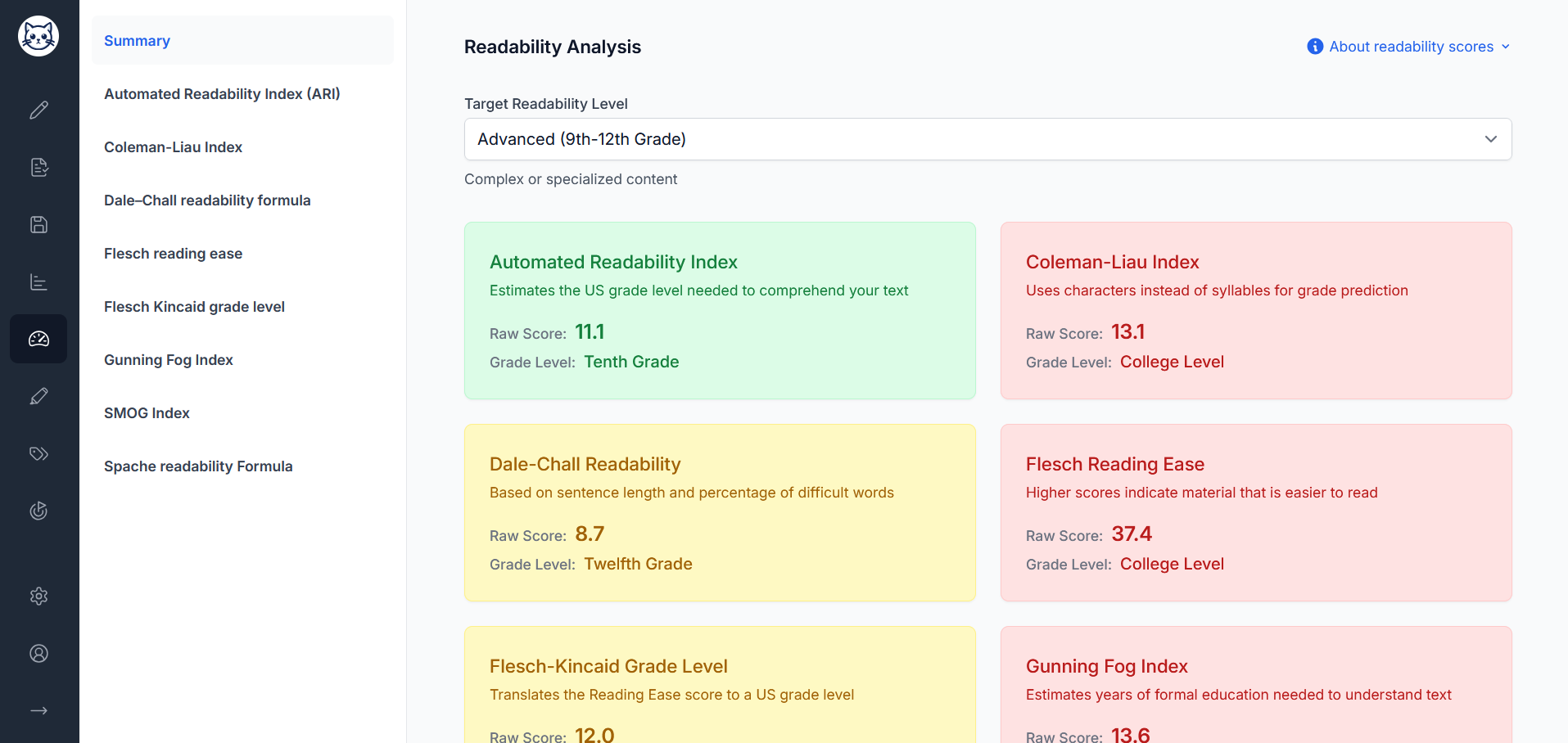Readability Scores Analysis
Evaluate your text complexity with comprehensive readability formulas. Understand the education level needed for your audience and optimize your content with detailed analysis from multiple established formulas.

How Readability Analysis Works
Readability scores help you assess how easy your text is to read and understand. Each formula measures readability differently, providing unique insights into your writing's complexity and accessibility.
- Multiple Readability Formulas
Access 8+ established readability formulas including Flesch-Kincaid, ARI, Coleman-Liau, Dale-Chall, and more. Each formula provides unique insights into text complexity.
- Grade Level Assessment
Get precise grade level assessments from kindergarten to college level. Understand the education level required for your target audience to comprehend your content.
- Visual Analysis Tools
Visualize readability with color-coded scales, detailed formula breakdowns, and interactive charts. See exactly how each metric evaluates your text complexity.
Comprehensive Readability Formulas
Each formula measures readability differently, giving you multiple perspectives on your text's complexity and accessibility.
Flesch Reading Ease
Rates text on a 100-point scale. Higher scores indicate material that is easier to read, with 90-100 being very easy and 0-30 being very difficult.
Flesch-Kincaid Grade Level
Translates the Reading Ease score to a US grade level, indicating the education level needed to comprehend the text.
Automated Readability Index (ARI)
Measures text complexity based on characters per word and words per sentence, providing a grade level estimate.
Coleman-Liau Index
Uses characters instead of syllables for grade prediction, making it more reliable for computer analysis.
Dale-Chall Readability
Based on sentence length and percentage of difficult words using a list of 3,000 words familiar to 4th-grade students.
Gunning Fog Index
Estimates the years of formal education needed to understand text on first reading, focusing on complex words.
SMOG Index
Calculates the grade level required to comprehend text based on the number of polysyllabic words.
Spache Readability Formula
Designed specifically for primary grade level materials, using a list of words familiar to elementary students.
Learn more about readability formulas in our readability guide
Advanced Analysis Features
Get deeper insights into your text's readability with comprehensive analysis tools and customization options.
Target Readability Levels
Set your target audience level and get color-coded feedback on how well your text matches. Choose from predefined targets like "General Public" (8th grade) or "Technical Content" for specialized documents.
Sample Summary View
Detailed Formula Analysis
Dive deep into each readability formula with visual breakdowns, actual calculations using your text data, and comprehensive grade level tables. Understand exactly how each metric evaluates your content.
Each formula page includes:
- Visual formula breakdown with your text values
- Interactive readability scale with color coding
- Complete grade level reference tables
Formula Visualization Example
Grade Level: 8.2
Difficult Words Highlighting
Premium FeatureSee exactly which words are considered "difficult" by the Dale-Chall formula. Words not found in the 3,000 familiar words list are highlighted in your text, helping you identify terms that might challenge your readers.
Example with difficult words highlighted:
The text uses advanced techniques to make writing more effective and easier to read.
Why Use Readability Analysis?
Ensure your content reaches and engages your intended audience with data-driven insights.
Content Accessibility
Ensure your content is accessible to your target audience by matching appropriate reading levels.
Educational Content
Create educational materials that match specific grade levels and learning objectives.
Professional Writing
Optimize business communications, reports, and documentation for clarity and professional impact.
Technical Documentation
Balance technical accuracy with readability for user manuals, API docs, and help content.
Premium Feature with Free Access
Readability Scores is a premium feature that's unlocked for all users twice per week. Get full access to all readability formulas, detailed analysis, and word highlighting without a subscription.
Free Access
Available twice weekly for all users. No subscription required to try the complete feature.
Premium Access
Unlimited access to all readability formulas and advanced analysis features.
Ready to Analyze Your Text?
Start using Gorby's comprehensive readability analysis today. Understand your text's complexity and optimize it for your target audience with detailed insights from multiple proven formulas.
